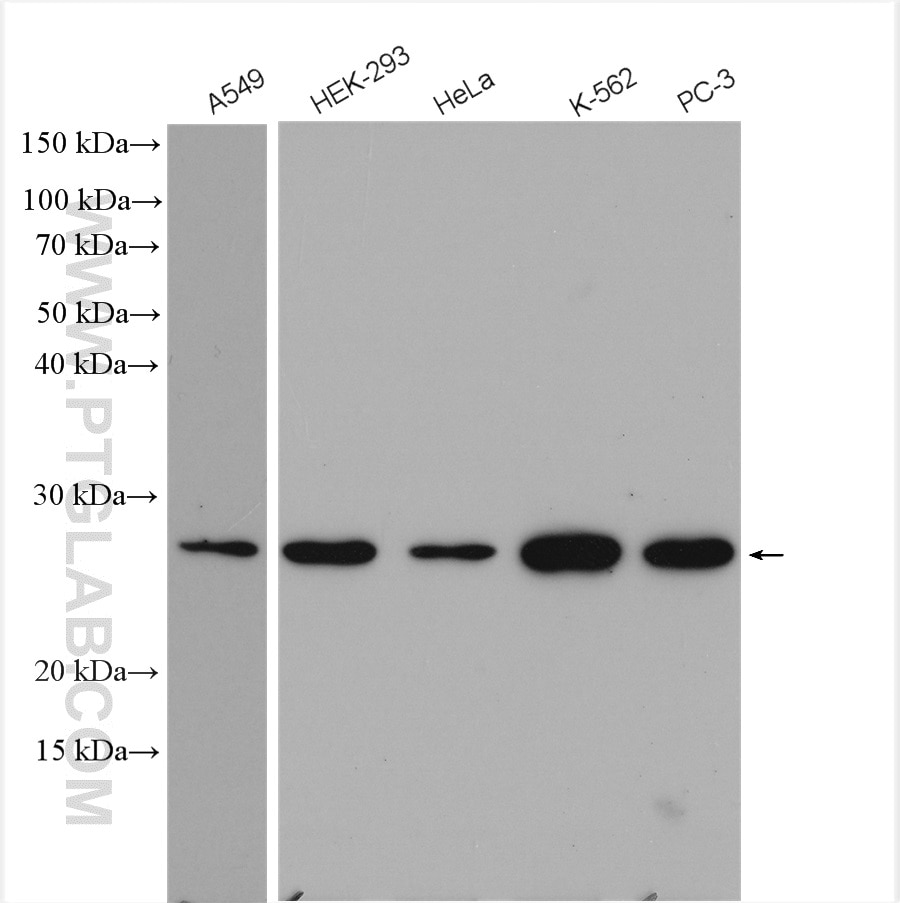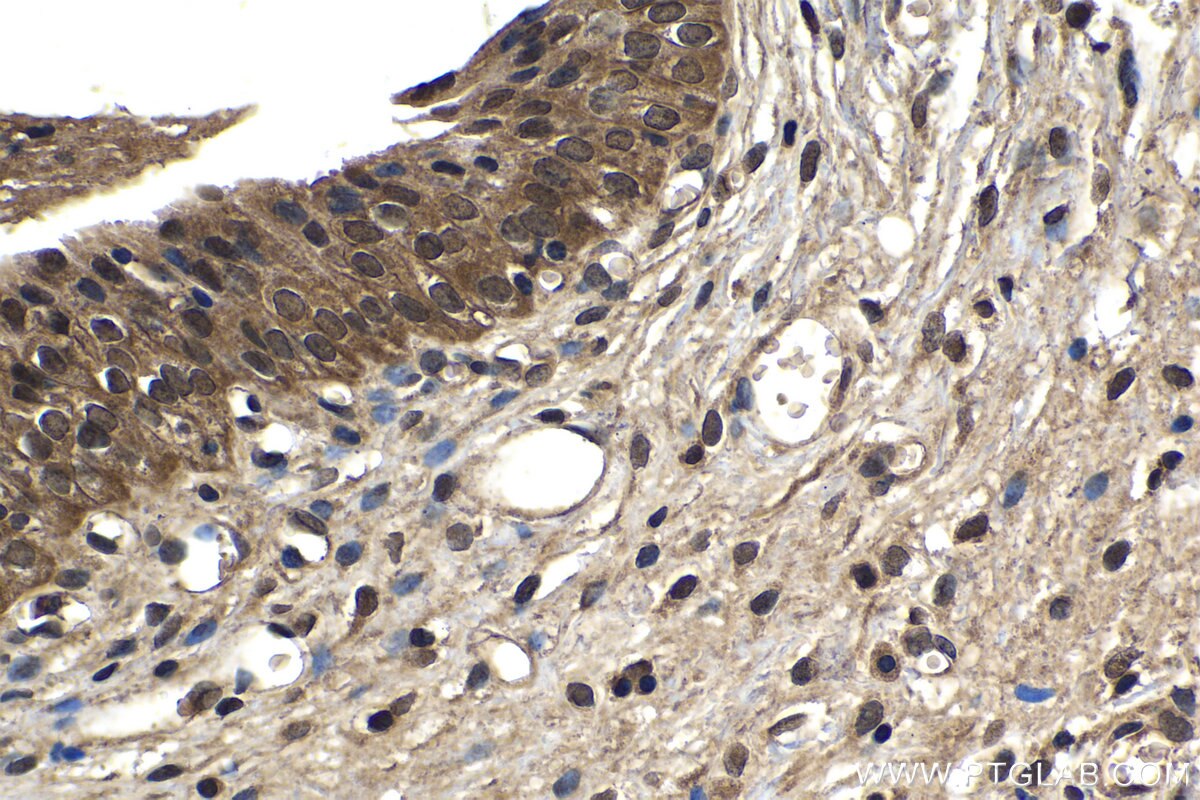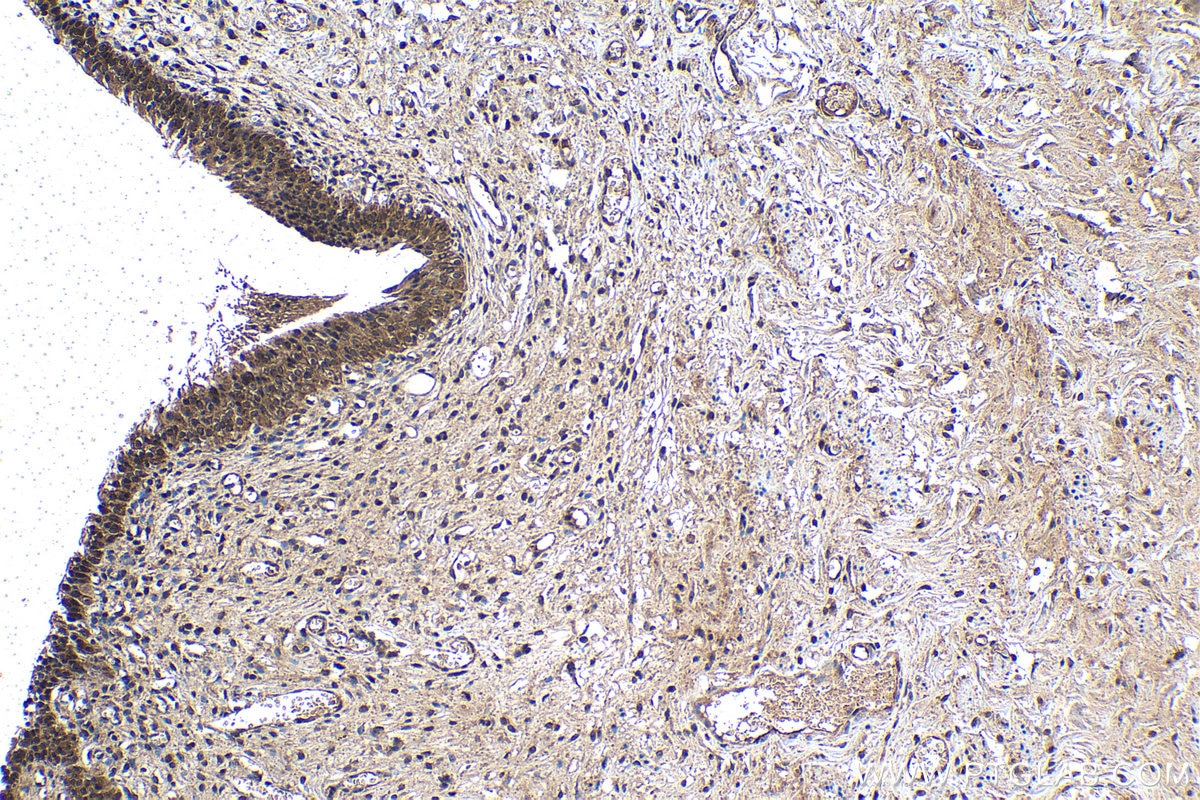PSMD10/Gankyrin Polyklonaler Antikörper
PSMD10/Gankyrin Polyklonal Antikörper für WB, IHC, ELISA
Wirt / Isotyp
Kaninchen / IgG
Getestete Reaktivität
human und mehr (1)
Anwendung
WB, IHC, ELISA
Konjugation
Unkonjugiert
Kat-Nr. : 12342-2-AP
Synonyme
Geprüfte Anwendungen
| Erfolgreiche Detektion in WB | A549-Zellen, HEK-293-Zellen, HeLa-Zellen, K-562-Zellen, PC-3-Zellen |
| Erfolgreiche Detektion in IHC | humanes Urothelkarzinomgewebe Hinweis: Antigendemaskierung mit TE-Puffer pH 9,0 empfohlen. (*) Wahlweise kann die Antigendemaskierung auch mit Citratpuffer pH 6,0 erfolgen. |
Empfohlene Verdünnung
| Anwendung | Verdünnung |
|---|---|
| Western Blot (WB) | WB : 1:500-1:2000 |
| Immunhistochemie (IHC) | IHC : 1:250-1:1000 |
| It is recommended that this reagent should be titrated in each testing system to obtain optimal results. | |
| Sample-dependent, check data in validation data gallery | |
Veröffentlichte Anwendungen
| KD/KO | See 1 publications below |
| WB | See 5 publications below |
Produktinformation
12342-2-AP bindet in WB, IHC, ELISA PSMD10/Gankyrin und zeigt Reaktivität mit human
| Getestete Reaktivität | human |
| In Publikationen genannte Reaktivität | human, Maus |
| Wirt / Isotyp | Kaninchen / IgG |
| Klonalität | Polyklonal |
| Typ | Antikörper |
| Immunogen | PSMD10/Gankyrin fusion protein Ag2994 |
| Vollständiger Name | proteasome (prosome, macropain) 26S subunit, non-ATPase, 10 |
| Berechnetes Molekulargewicht | 226 aa, 24 kDa |
| Beobachtetes Molekulargewicht | 24-28 kDa |
| GenBank-Zugangsnummer | BC011960 |
| Gene symbol | PSMD10 |
| Gene ID (NCBI) | 5716 |
| Konjugation | Unkonjugiert |
| Form | Liquid |
| Reinigungsmethode | Antigen-Affinitätsreinigung |
| Lagerungspuffer | PBS with 0.02% sodium azide and 50% glycerol |
| Lagerungsbedingungen | Bei -20°C lagern. Nach dem Versand ein Jahr lang stabil Aliquotieren ist bei -20oC Lagerung nicht notwendig. 20ul Größen enthalten 0,1% BSA. |
Hintergrundinformationen
PSMD10, also known as Gankyrin, is a subunit of the 19S regulatory particle of the proteasome and plays a crucial role in protein degradation. It is a small, 25 kDa cytoplasmic-nuclear shuttling protein, highly conserved throughout evolution (~40% identity to yeast Nas6p). PSMD10 is involved in the regulation of cell cycle progression and apoptosis by interacting with key proteins such as p53 and Rb. PSMD10 has been identified as an oncoprotein, promoting tumor cell proliferation and survival in various cancers (PMID: 16581249, PMID: 31576540).
Protokolle
| PRODUKTSPEZIFISCHE PROTOKOLLE | |
|---|---|
| WB protocol for PSMD10/Gankyrin antibody 12342-2-AP | Protokoll herunterladen |
| IHC protocol for PSMD10/Gankyrin antibody 12342-2-AP | Protokoll herunterladenl |
| STANDARD-PROTOKOLLE | |
|---|---|
| Klicken Sie hier, um unsere Standardprotokolle anzuzeigen |
Publikationen
| Species | Application | Title |
|---|---|---|
J Biomed Sci Znf179 E3 ligase-mediated TDP-43 polyubiquitination is involved in TDP-43- ubiquitinated inclusions (UBI) (+)-related neurodegenerative pathology. | ||
Appl Biochem Biotechnol miR-188-5p and Host MALAT1 Regulate RBE Cell Migration, Invasion, and Apoptosis via Up-regulating PSMD10 in Cholangiocarcinoma | ||
Research (Wash D C) SERBP1 Promotes Stress Granule Clearance by Regulating 26S Proteasome Activity and G3BP1 Ubiquitination and Protects Male Germ Cells from Thermostimuli Damage | ||
Elife A cleaved METTL3 potentiates the METTL3-WTAP interaction and breast cancer progression | ||
Nat Commun RNF167 mediates atypical ubiquitylation and degradation of RLRs via two distinct proteolytic pathways
|




